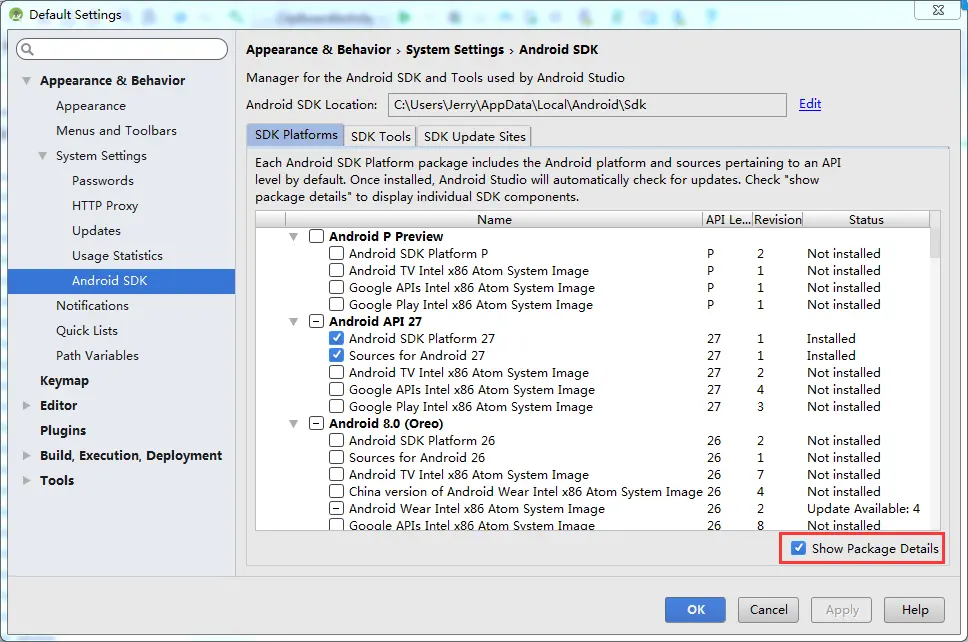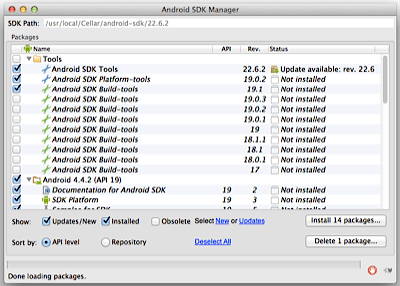- Mac Install Android Sdk Manager
- Mac Os X Install Android Sdk
- Linux Install Android Sdk
- Mac Os Install Android Sdk
This is the solution to Unity not recognising the SDK, by the way - go to Android Studio edit preferences sdk manager, de-select 'hide obsolete' and select 'show detail', then expand the level 26 sdk and select the 'tools' for installation, apply, ok, and boom, your sdk location will be recognised by Unity! ANDROIDSDKROOT=undefined (recommended setting) ANDROIDHOME=C: Users Zohab Ud Din AppData Local Android Sdk (DEPRECATED) You need to add this variable environment missing: ANDROIDSDKROOT (please adapt if you not use osx, looking for 'environment variable'). Enable Android Auto developer mode by starting the Android Auto companion app and tapping on the header image 10 times. This is a one-time step. Start the head unit server in the companion app by clicking on the context menu, and selecting “Start head unit server”.
Introduction
This document will guide you through installing the Intel® Atom™ x86 image for Android* KitKat, which can be used for development on Intel’s x86 architecture.
Prerequisites

The Android x86 Emulator Image requires the Android SDK to be installed. For instructions on installing and configuring the Android SDK, refer to the Android developer website (http://developer.android.com/sdk/).


Optional: The x86 Emulator Image for Android can be accelerated using Intel Hardware Accelerated Execution Manager (HAXM). For more information, refer to the 'Optimization' section of this document.
Installation

Downloading Manually (Instructions for both Windows and Mac OSX)
- Close any open SDK or AVD windows.
- Go to http://www.intel.com/software/android.
- Click Tools & Downloads
- Download the Intel x86 Atom System Image
(Android* 4.4 KitKat x86 Emulator System Image).
Windows
- Navigate to the directory where the Android SDK is located. If you installed using an executable for the installation, you can find the Android SDK in the following locations.
- If you installed for “everyone” on 64bit: 'c:Program Files (x86)android' 32bit: 'c:Program Filesandroid'
- If installed “just for me”: 'c:users<username>AppDatalocalandroid'
- The following instructions and screenshots are for a windows install 'just for me' but the files need to be extracted to the same relative path to your Android install
- The system-images directory contains Android system images, separated by architecture: If a “system-images” directory or an 'android-19' directory does not exist then you will need to create it.
- Expand android-19 (this directory contains API Level 19 system images):
- Extract the x86 directory contained in the downloaded system image archive directly into the android-19 directory. The directory “./Android-SDK/system-images/android-19/x86/” should have the following files:
- The system image is now installed and ready to be used.
Mac OSX
- Navigate to the directory where you extracted the SDK
- The system-images directory contains Android system images, separated by architecture: If a “system-images” directory or an 'android-19' directory does not exist then you will need to create it / them.
- Expand android-19(this directory contains API Level 19 system images):
- Extract the x86 directory contained in the downloaded system image archive directly into the android-19 directory. The directory “./android-sdk-macosx/system-images/android-19/x86/” should have the following files:
- The system image is now installed and ready to be used.
Using the System Image
- Start the Android AVD Manager and create a new AVD, setting 'Target' to 'Android 4.4 – API Level 19', and 'CPU/ABI' to 'Intel Atom (x86)'.
The Intel Atom x86 Image for Android KitKat can make use of hardware GPU features to increase the performance of games, graphics-intensive programs, and user interface elements. For the best performance make sure to check the 'Use Host GPU' Box when creating the image.
Note:The functionality and performance of GPU acceleration is highly dependent on your computer’s graphics card and graphics drivers. GPU acceleration must be enabled on a per AVD basis.
Note: if the 'Intel Atom (x86)' CPU/ABI option is not available, make sure that the system image is installed correctly. You can confirm the system image installation by opening the Android SDK manger and looking at the status of the “Intel x86 Atom System Image” under “Android 4.4 (API 19)” - Click the 'Create AVD' button.
- The AVD has been successfully created and is now ready to use:
Optimization
Mac Install Android Sdk Manager
CPU Acceleration

Mac Os X Install Android Sdk
The performance of the Intel Atom x86 Image for Android KitKat can be improved with hardware-based virtualization using Intel VT-x technology.
Linux Install Android Sdk
If your computer has an Intel processor with VT-x support, it is recommended that Intel Hardware Acceleration Execution Manager (HAXM) be used in conjunction with this system image. For more information about Intel HAXM, visit http://www.intel.com/software/android.
Mac Os Install Android Sdk
Note: Intel HAXM is for Windows and OS X operating systems only. For Linux hosts, Kernel-based Virtual Machine (KVM) can be used to accelerate emulation performance. For information on installing and configuring KVM on Ubuntu, refer to this guide:https://help.ubuntu.com/community/KVM/Installation
